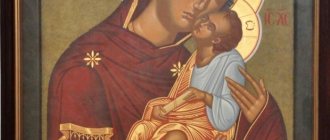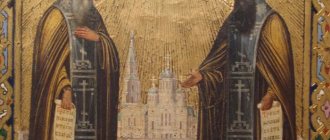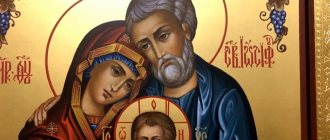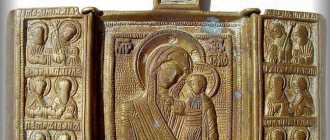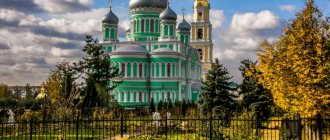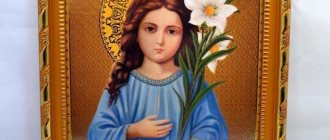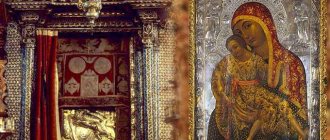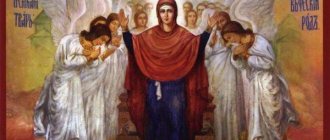History of appearance
The miracle of the appearance of the icon, called “The Leaping of the Baby,” occurred at the end of the 17th century near the Nikolo-Ugreshskaya monastic monastery. The monastery was erected on a fertile place where the Russian prince Dmitry Donskoy found the icon of St. Nicholas the Pleasant, which ended up on the tree of God. Prince Dmitry was facing a battle on the Kulikovo Field. He asked for help from the miraculous face of St. Nicholas and received it during a victorious battle.
The description of the event of the discovery of the iconographic image in which the Child of God plays with the Mother has not been preserved. Only the date of the appearance of the shrine is known (November 20) and the place not far from the walls of the monastery, built by order of Prince Donskoy.
The original image of the “Baby Leaping” was lost during the civil war, when churches and monasteries were massively plundered. To this day, miraculous copies from the icon have been preserved. The list closest to the original was created 19 years after the miraculous appearance of the shrine. The icon is kept in the State Museum-Reserve in Moscow. Lists were also made from the image, one of which was returned to the place where the original image was found, to the Nikolo-Ugreshsky monastery.
In 2003, an event akin to the rediscovery of an icon occurred. A believing woman handed over to the monastery a list close to the prototype and made in a similar iconographic type, called “Tenderness.” The icon, delivered by procession to the gates of the monastery, was placed within the walls of the Transfiguration Cathedral, in the place where the newly-minted shrine had previously been located.
Where is it now?
After the revolution of 1917, the Nikolo-Ugreshsky Monastery was destroyed, and the icon was stolen by unknown people. In 2003, one of the parishioners brought to the temple an image that surprisingly resembled the lost shrine. Today every Orthodox Christian can worship her.
There are lists of “Leaps”, the places of preservation of which are the Tretyakov Gallery and the Novodevichy Convent in Moscow. The miraculous icon of the Mother of God is in the Athos Vatopedi Monastery. The faces of mother and baby, which are located in Balkan and Greek temples, have demonstrated their miraculous power more than once. Photos of different lists of icons can be seen below:
Description and meaning
In the Ugresh icon painting, the Mother of God appears before believers with the Son of God in her arms. The baby plays with the Mother like a child of a simple person, playfully throwing his head towards Mary’s face and affectionately touching Her cheek with his palm. The Mother leans towards the Child and, lovingly, presses her cheek to the Baby.
The face of the Virgin Mary reflects the humble sadness of a mother who knows about the great saving mission and the upcoming torment prepared for Jesus. She accepts the will of God and understands the highest goal, but she sincerely loves and pities her child.
The image on the icon, carrying human emotions and righteous feelings, shows the moment that brings the Divine principle of the Savior closer to people, for whom he will accept a terrible death and ascend to the Kingdom of Heaven for eternal life, helping those praying, the righteous who have come to God, for the salvation and forgiveness of sinful souls .
Traditionally, the plot of the icon is depicted on a gold background, which indicates the Divinity of the images, as well as on a blue or light green background. The head of the Virgin Mary, illuminated by a classical or lace halo, is covered with a white, gold, blue or red cape, complemented by one or more Bethlehem stars. The main robe and dress of the Mother are made in the same colors, symbolizing purity and purity.
The naked hands and feet of the Son of God symbolically point to the future crucifixion. There are lists in which the baby Jesus holds an unfolded scroll of holy scripture in his hand. The scroll is addressed in text to the people, which symbolizes the Christian teaching that the Savior will bring and tell to the people.
Lists of the iconographic image “Baby Leaping” may differ from each other in detail, preserving the basic structure and plot of the captured moment.
Icon of the Mother of God “Leaping Baby”
The icon in question belongs to the most common type in iconography, called “eleusa,” which is translated from Greek as “merciful.” Such works most fully depict the deeply reverent and tender relationship between the Holy Mother and the Divine Child. Here there is no distance between Mother and Son: the Baby presses his cheek to the face of the Virgin Mary, showing her his sincere love and trust. Many famous icons of the Mother of God, such as Vladimir, Tenderness, Yaroslavl and others, also belong to the “eleus” type.
The icon depicts the Savior Jesus Christ sitting on the hand of the Mother of God. Throwing his head back, He seems to be playing with His Mother. With one hand the Savior touches her cheek, thereby showing tenderness. The entire pose of the Infant God conveys His childlike, spontaneous character. This icon most strongly shows the human side of the Divine Savior, which is rarely found in other iconographic images of the Mother of God.
What do they ask for before the image?
Since the discovery of the miraculous image, women have been praying before the face of the Mother of God with the playing Child, asking for the conception, birth and health of their children.
Appealing to the Mother of God and the Lord in front of the “Leaping of the Baby” icon helps believers:
- create a family;
- heal from infertility;
- to conceive and bear a fetus in the womb;
- facilitate childbirth;
- raise healthy and obedient children;
- resolve family conflicts;
- restore mutual understanding and harmony in the relationship between husband and wife.
In front of the “Leaping” icon, parents also ask for guidance on the true path of their children, for them to acquire Orthodoxy and faith in the Lord God.
Praying is allowed both in church and at home. The main conditions are sincere faith and hope for help from above. During prayer, you should not be distracted or think about worldly affairs. All attention and thoughts should be focused on the spoken words.
In order to pray fruitfully at home, believers purchase an icon and church candles. Candles are lit during prayer for peace and mood. Before the images of the saints' faces, Orthodox texts are read, and they also address the Heavenly Intercessors in their own words.
Prayer
Most Holy Virgin, Mother of our Lord Jesus Christ, who weighed the birth and nature of mother and child, have mercy on Thy servant (your name) and help at this hour so that her burden may be resolved safely. O all-merciful Lady Theotokos, even though you did not require help in the birth of the Son of God, grant help to this servant of yours who requires help, especially from You. Grant her blessings at this hour, and grant her the birth of a child and bring her into the light of this world at the right time and the gift of intelligent light in holy baptism with water and spirit. We fall down before you, Mother of the Most High God, praying: Be merciful to this mother, the time has come for her to be a mother, and beg Christ our God, who has become incarnate from you, to strengthen you with his power from above. Amen
How to place it in the house
According to Orthodox traditions, it is customary to place icons in the house on a special shelf in the right corner of the room, which in Rus' was called the “Red Corner”. Usually, for this purpose, they build a separate shelf and place on it only images of saints, candles, a lamp, Orthodox books and everything related to God and the church.
It is allowed to place icons on a separate shelf of an open shelving unit or cabinet, as well as hang them on the wall. The place should be bright and clean. Several icons are arranged in an order corresponding to the hierarchy, placing the image of the Lord Pantocrator or the Trinity in the center.
The image “Baby Leaping” is appropriate to put:
- in the bedroom of an unmarried girl who wants to start a family;
- in the matrimonial bedroom;
- in the children's room.
While honoring the shrine and turning to the Lord and the Mother of God, one should not forget that one must live honestly, righteously, not wishing harm to others, not slander and observe the Orthodox commandments of Christ.
Origin of the image
Researchers of the icon are inclined to believe that the “Leaping of the Child” is of Byzantine origin. This school has long been revered in Rus'. In Byzantium itself the image was revered as miraculous. But the well-known name was assigned to it already in Russia, in the 16th-17th centuries.
Tested for generations: we make effective fertilizing for seedlings
A simple way to grow a new flower from the stump of a wilted orchid
Bringing the rose bush back to life after winter: how to properly reanimate flowers
Spiritual Fruits
Prayer has a healing effect on the soul. After it, the woman receives consolation in her worries. Cares no longer seem overwhelming to her, peace and tranquility reign in her heart. This is how the Queen of Heaven helps everyone who believes.
Spiritual fathers advise praying regularly - every day in the morning and evening. After reading the prayer book, you can turn to the saints and the Mother of God in your own words. Here is an example of such a prayer: “Most Holy Mother of God, have mercy on your servant (name), provide assistance during the pangs of birth that all the daughters of Eve experience.
Blessed among wives, remember how you rushed to meet your relative Elizabeth when she was pregnant, and how this blessedly affected her!
By your great mercy, allow me to be safely relieved of my burden. May the child that I carry under my heart joyfully worship our Savior and Lord Jesus Christ, like the holy baby John.
Do not be ashamed of my hope in you, Most Pure Virgin, look upon me, a poor sinner, that I may glorify you forever. Amen".
Spiritual life will undoubtedly bear fruit. This will be useful not only for the soul of the expectant mother, but also for the future baby.
Found a violation? Report content
Features of iconography
In this case, painters emphasize the emotional side of the relationship between the Son and Mother. The name “Baby Leaping” is of Russian origin. It was used as a term among icon painters, but was not used on the icon itself.
- The Mother of God holds the Child on her right (sometimes also on her left) hand.
- Jesus throws his head back sharply.
- The entire figure of the Baby expresses impatience, impetus, so that the Mother has to restrain the Son.
- Jesus' hands reach toward Mary's face or chin.
- Christ's legs are crossed, usually the Mother holds the child by one of them.
Work as a courier at Yandex.Eda (up to 3,400 rubles per shift) leave a request →
During some trials, the Baby grabbed the edge of the Mother’s omophorion and pulled it towards himself. The posture of Christ is of particular importance here. It's like he's leaning back. Many experts draw an analogy with the image of the Presentation, where the child escapes from the hands of Mary, trying to quickly get to Simeon. The wise old man was the first to make a prediction that Mary would experience a lot of mental suffering.
A hint of the Way of the Cross of the Infant is often visible in the mournful expression on the face of the Mother of God. Today there are quite a few variants of this image, but in any of them the pose of Christ will be special. On a number of icons, the color of the omophorion of the Queen of Heaven is black (usually it is crimson, sometimes green or even blue). But in this case, the color is a sign of mourning for the Son, which awaits her in the future.
We know of the “Leaping Child” icon from the 15th century, which belongs to the author Angelos Akotantos, a famous master from Byzantium. It is called “Cardiotissa” - that is, cardiac, but this is only an epithet, a characteristic. Here both joy and tragedy are masterfully combined into one image. The festive mood after the Incarnation is darkened by the anticipation of the future Calvary sacrifice. The image was brought to Moscow as part of an exhibition of Byzantine art.
